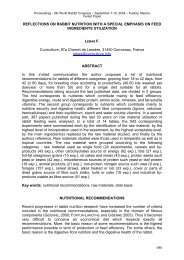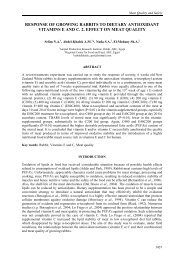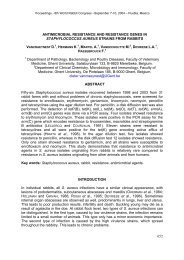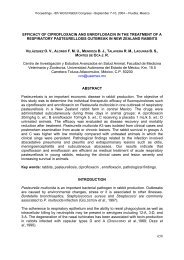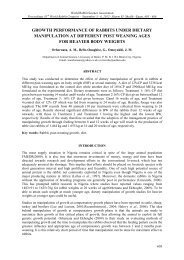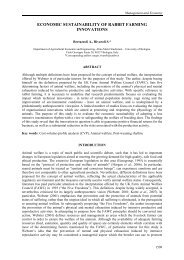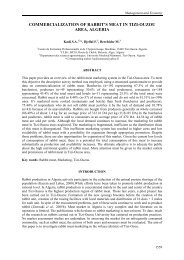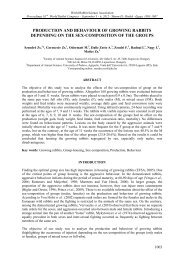effect of dietary supplementation with rapeseed and fish oil mixture ...
effect of dietary supplementation with rapeseed and fish oil mixture ...
effect of dietary supplementation with rapeseed and fish oil mixture ...
Create successful ePaper yourself
Turn your PDF publications into a flip-book with our unique Google optimized e-Paper software.
9 th World Rabbit Congress – June 10-13, 2008 – Verona – ItalyTable 3: Level <strong>of</strong> fatty acids (% total acids), total cholesterol (mg/100 g) <strong>and</strong> TBA (mg/kg) in themuscle tissue <strong>of</strong> hind legItem Group - I Group - II Group – III seC8:0 0.03 0.01 0.02 0.02C10:0 0.53A 0.10B 0.14B 0.18C12:0 0.34 0.10 0.14 0.10C14:0 2.41a 2.51a 3.28b 0.16C16:0 21.8a 17.6ab 19.9b 1.17C16:1 3.25 3.27 4.22 0.45C18:0 5.45 4.44 4.48 0.19C18:1 21.8A 17.1B 17.9B 0.61C18:2n-6 38.5 38.7 35.1 1.41C18:3n-3 2.12A 5.47B 3.95B 0.93C20:0 0.09A 0.06B 0.05B 0.01CLAc9t11 0.05 0.06 0.06 0.01CLAt10c12 0.01A 0.09B 0.08B 0.01CLAc9c11 0.01 0.01 0.01 0.01CLAt9t11 0.51A 1.29B 1.32B 0.12C20:4n-6 1.77A 0.95B 0.88B 0.12C22:1 0.03 0.02 0.06 0.04C20:5n-3(EPA) 0.13A 1.52B 1.70B 0.01C22:6n-3(DHA) 0.93A 6.32B 6,38B 0.17SFA 30.7a 24.9b 28.0b 1.48PUFA 44.2A 54.6B 49.7B 1.90PUFAn-6 40.4 39.8 36,1 1.38PUFAn-3 3.20A 13.3B 12.0B 0.91PUFA/SFA 1.44A 2.20B 1.78A 0.18PUFAn-6/n-3 13.4A 3.01B 3.05B 1.12Cholesterol 66.3a 60.5 57.5b 3.61Vitamin E 1.81A 2.19A 3,56B 0.47TBA-RS14 0.34A 0.33A 0.17B 0.25TBA-RS90 0.51A 0.52A 0.20B 0.14a,b: means <strong>with</strong> different letters differ significantly at P≤0.05, A,B: at P≤0.01The addition <strong>of</strong> vitamin E to the diet at a rate <strong>of</strong> 100 mg/kg had a beneficial <strong>effect</strong> on reducing thesusceptibility <strong>of</strong> muscle lipids to oxidation processes during the frozen storage <strong>of</strong> meat. Similarfindings were reported by Connor (2000) <strong>and</strong> Ramirez et al. (2005), who showed a positive <strong>effect</strong> <strong>of</strong>adding fat to rabbit diets on the level <strong>of</strong> desirable fatty acids <strong>and</strong> on reducing cholesterol in rabbitmeat.Cooking was applied as the meat preparation method for sensory analysis <strong>of</strong> the musculus longissimusdorsi (Table 4). This resulted from the fact that the analysis should give special attention to the aroma<strong>of</strong> the samples. This heat treatment method is the most <strong>effect</strong>ive in eliciting the intensity <strong>and</strong> typicalaroma <strong>of</strong> rabbit meat, <strong>and</strong> is not objected to by panelists on the grounds <strong>of</strong> the samples beingundercooked. No statistical differences were found between the groups in the overall sensory quality,which shows that the addition <strong>of</strong> <strong>rapeseed</strong> <strong>and</strong> <strong>fish</strong> <strong>oil</strong>s had no negative <strong>effect</strong> on the sensory traits <strong>of</strong>meat.Table 4: Sensory traits <strong>of</strong> meat (mean scores)Trait Group I Group II Group III seAroma intensity 4.8 4.8 4.8 0.01Aroma quality 4.2 4.0 4.0 0.05Tenderness 4.4 4.8 4.8 0.22Juiciness 4.4 4.6 4.6 0.07Taste intensity 4.0 4.0 4.0 0.01Taste quality 4.6 4.6 4.6 0.01Overall sensory quality 4.40 4.45 4.46 0.06CONCLUSIONSIn summary, the addition <strong>of</strong> <strong>rapeseed</strong> <strong>oil</strong> (2%) <strong>and</strong> <strong>fish</strong> <strong>oil</strong> (1%) to rabbit diets had a favourable <strong>effect</strong>on the composition <strong>of</strong> the meat lipid fraction. There was a decrease in the total level <strong>of</strong> saturated fatty1374





